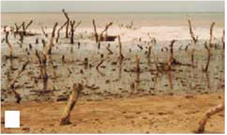/topics/surface-water
Surface Water
KRAPAVIS:Reviving "Orans" physically and conceptually
Posted on 13 Aug, 2008 04:39 AMOrans are local micro bio-diversity reserves- community conserved areas (CCAs) harboring the shrine of a local goddess or deity. Also known as Dev-banis, these local forests vary in size from a hundred to five hundred bighas (about hundred hectares). Most Orans have sources of water, either small springs or rivulets running through them or a variety of ponds and nadis in their midst.
Environmental flows discussion-From the perspective of the National Water Academy
Posted on 02 Jul, 2008 09:31 AMParineeta Dandekar's earlier post on environmental flows, triggered several responses and we have initiated a discussion forum
Anupam Mishra's books on water - Aaj Bhi Khare Hain Talaab & Rajasthan Ki Rajat Boondein
Posted on 20 Jun, 2008 06:40 AMShri Anupam Mishra, Gandhian and environmentalist is a remarkable person. He lays no claim to copyright for his own books and (similiar to open source software) it has increased the dissemination of his message. During a recent visit to his office at Gandhi Peace Foundation in New Delhi, he showed several different editions of "Aaj Bhi Khare Hai Talaab" brought out by all kinds of individuals and publishers across the country. He recounts the story of how a impoverished young person was inspired to translate it into Punjabi and get it published.
Latest from AAQ and discussion forum
Posted on 17 Jun, 2008 09:40 AMWould you throw your lot in with cloud seeding, or have ideas regarding conservation and regulated usage? Feel free to join in and have your say, access the Drought Mitigation Discussion here
Invitation for joining URAN PSI group
Posted on 18 May, 2008 10:48 PMSeveral threats have emerged in recent years to the pristine Himalayan rivers of Uttarakhand. These include: (i) the proposed construction of 220 dams (ii) the drying up of rain fed rivers due to deforestation and deforestation of their catchments (iii) release of untreated sewage from river side towns and habitations and (iv) illegal sand mining of river beds.
Prof.G. D. Agrawal's satyagraha against the construction of dams on the Bhagirathi River
Posted on 17 May, 2008 09:08 AM
Pained by the unrelenting destruction of the Ganga river, especially by a series of dams in its upper reaches, Dr G.D. Agrawal, India's pre-eminent environmental quality scientist and a legendary Professor (and HoD) of Civil & Environmental Engineering at IIT-Kanpur. (Access:Biography Sketch Here) has decided to go on a fast-unto-death to oppose its continuing desecration. His conviction that we are staring at an unprecedented ecological and cultural catastrophe comes from his powerfully logical mind. Critique on proposed dams on Bhagirathi River. Access here: Critique on Dams
SwissRe International ReSource Award for Sustainable Watershed Management 2009
Posted on 26 Apr, 2008 08:39 AMForwarded to the Portal by Anuradha Pati Recognises the planning, evaluation, and implementation of water-related projects with the aim of promoting awareness and encouraging the efficient use of this resource. The International ReSource Award is worth US$150,000 in total and is granted to one or several projects selected by an international jury.
Environmental flows for Indian rivers:Need for a discussion to consider the health of the riverine ecosystems
Posted on 24 Apr, 2008 11:58 PMIndia is facing a water crisis in nearly all the sectors. Fortunately or unfortunately, measures taken by the related authorities to combat the crisis often depends on the amount of 'noise' made by the relevant stakeholders. It is no wonder then, that the urban India, and especially the rich and the powerful in urban India, seldom have to face problems related to water scarcity, water quality or the sheer inequity in distribution. On the other hand, weaker the stakeholder, more severe are his ( rather 'her') problems. Marginal farmers, tail enders in a canal network, rural and urban poor, especially children and women, stand testimony to this situation. We all agree to this, right? 
Godavari delta, destruction of mangroves
But aren't we forgetting the the weakest, and in some ways, the strongest, of all the stakeholders? How about the ecosystem of the river itself??
"Himalaya: Man and Nature": Newsletter, Nov 2007 in English and Hindi
Posted on 05 Mar, 2008 10:59 PMThe Nov 2007 edition of "Himalaya: Man and Nature", a newsletter about ecological issues of the mountain areas of Uttarakhand and neighbouring areas is available here : http://www.himalayanwater.org/media/download_gallery/Himalaya%20Man%20&%20Nature,%20Nov-07.pdf The newsletter c






